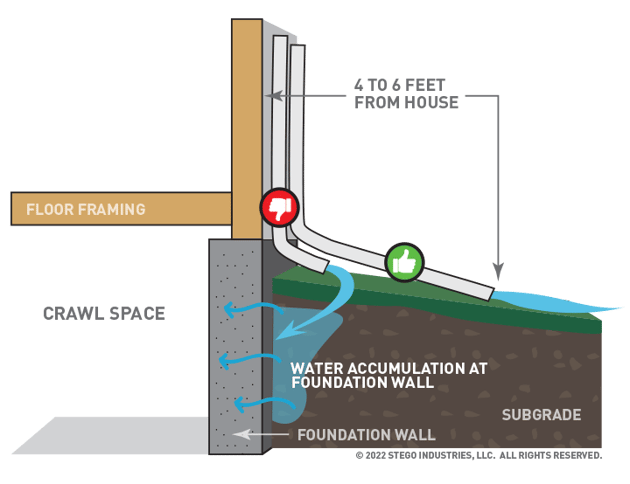The Must-Have Crawl Space Inspection Checklist for Summer
5 Reasons Why the Summer Months, With Hot, Humid Temperatures, Can Lead to Crawl Space Problems that Affect the Entire Home
.png?width=720&height=378&name=Crawl-Space-Inspection-Checklist-1200x630px%20(1).png) For many homeowners, the seasonal transition from winter to summer brings warm, hot, and often humid weather. People also come out of their own hibernation and get outside to tackle a range of home maintenance or beautification projects: sprucing up the outdoor living area, cleaning the grill for BBQ season, dusting off the lawn mower, and most likely turning on that vital air conditioning.
For many homeowners, the seasonal transition from winter to summer brings warm, hot, and often humid weather. People also come out of their own hibernation and get outside to tackle a range of home maintenance or beautification projects: sprucing up the outdoor living area, cleaning the grill for BBQ season, dusting off the lawn mower, and most likely turning on that vital air conditioning.
But if your home has a crawl space, a “checkup” to this often-forgotten part of the home is a key element to a to-do list that can make for a more comfortable summer indoors. Despite how infrequently you may go into your crawl space, it represents an area of the home that often has a big impact on:
Despite how infrequently you may go into your crawl space, it represents an area of the home that often has a big impact on:
- indoor air quality,
- energy efficiency, and
- long-term ownership costs.
Here are 5 reasons why the summer months, with hot, humid temperatures, can lead to crawl space problems that affect the entire home.
Hot, Humid Air Infiltration
In many areas of the country, summer means hot temperatures and high humidity outside. Our homes are equipped to keep the heat and humidity out, to stay comfortable inside.
That logic hasn’t always applied to crawl spaces. The traditional approach to crawl spaces, especially in older homes, has been open vents built into the foundation wall. The thought was this natural ventilation allowed air movement in and out of the crawl space in hopes of keeping it dry and “fresh”. However, open crawl space foundation vents often cause more harm than good, especially when hot, humid air is allowed to easily migrate in.
Outside air with a high relative humidity (RH) has a lot of moisture (in vapor form) in it. The amount of moisture air can hold is dependent on temperature – the lower the temperature, the less it can hold.
Crawl spaces, being mostly below-grade, are naturally cooler areas, especially compared to outside air in the summer. Crawl spaces also contain many cold surfaces – wood framing, concrete wall, metal HVAC equipment, etc. -- for moist air to condense onto.
Condensation occurs when air around any cool surface can no longer hold the amount of moisture vapor in it. The vapor turns to water and collects on these colder surfaces below the dew point temperature. It’s just like seeing condensation on the glass of a cold drink.
 Humid air venting -- and the resulting condensation of liquid water -- in the crawl space can contribute to a range of significant problems, including mold/mildew growth, wood rot to floor joists, damage to insulation, corrosion of HVAC equipment, etc.
Humid air venting -- and the resulting condensation of liquid water -- in the crawl space can contribute to a range of significant problems, including mold/mildew growth, wood rot to floor joists, damage to insulation, corrosion of HVAC equipment, etc.
HVAC Inefficiency
In most cases, during warm months of the year, we try to keep the main interior living area of the home cool, often with the air conditioning running. One of the benefits of a crawl space is that it provides a useful area to locate HVAC equipment and ducting. The ducts carry the conditioned air (in this case, cool air) to all rooms in the home. When hot outside air passes through foundation vents into the crawl space, it can heat up the duct equipment (particularly if the ducts are not insulated). That’s warming the cool air the HVAC system just pumped into the house!
This can get especially problematic if the ducts in the crawl space are also leaky – the cool, conditioned air escapes and the hot air from the crawl space gets in: a terribly inefficient situation that impacts both comfort and your energy bills 💲💲💲.
Liquid Water Intrusion
Liquid water intrusion into a home’s foundation can come from many sources. A common one to consider is water around the home’s foundation from summer rainstorms or regular home maintenance, like landscaping.
Of course, we want our gardens to look beautiful in the spring and summer but pay attention to liquid water around the crawl space: it can lead to bulk water pressure against the below-grade wall or could easily find its way in through open crawl space vents.
Simple steps to help prevent liquid water intrusion include:
- Create positive drainage away from the foundation – the exterior grade sloped down and away from the home.
- Move flowers, gardens, and shrubs farther from the foundation.
- Check gutter downspouts and make sure they are working and moving water a proper distance away from the home.

Insects and Rodents
A dark, moist crawl space can be a popular area for pests like insects and rodents. Subterranean termites, potentially the most destructive pest, generally swarm and forage in the spring and early summer.
Rodents like mice and rats can also be active during summer months and find the relatively undisturbed crawl space a safe haven, especially if there is a food source or comfortable place to burrow – like fiberglass insulation.
The life (and death) of insects and rodents can pose several concerns in the crawl space, including allergens, odors, and contamination.
(Reverse) Stack Effect
Everyone knows the saying that hot air rises in a home. Hot air is less dense than cooler air, so it moves upward from lower portions of the home and gets pushed out (exfiltration) through gaps in the envelope at the upper floors of the home. Yet, any air that moves out of the home must be replaced to maintain equilibrium, leading to more air moving in (infiltration) at the bottom floors of the home. This is the stack effect at work, the natural movement of air in, through, and out of homes through air gaps in the building envelope. Stack effect is generally stronger in colder months of the year -- when we are heating the home -- due to larger differentials between the interior and outside of the home.
However, in the summer months, when we generally are cooling the home, stack effect actually tends to work in reverse. Hot air is drawn into the home at the upper floors forcing cooled, conditioned air towards and out of the bottom floors of the home, including the crawl space. Openings in the crawl space, then, offer an easy pathway for the conditioned air (we are paying to condition) to escape. This reverse stack effect can have a significant impact on the efficiency and costs of running the HVAC system in the summer. Part of the solution in reducing the impacts of stack effect (“normal” or reverse) in homes is closing or sealing gaps in the home envelope that allow air to move in or out, including the crawl space.
Another important point: if the crawl space is dirty, smelly, or wet (potentially as a result of hot, humid summer conditions), the air in the crawl space is too, and that same air can move through your entire home as seasons change. Without attention, it’s a vicious cycle likely to mount over time.
Get Ready – Here’s the Must-Have Crawl Space Inspection Checklist
During the warm weather months when you find yourself working around the house, it might be a good time to take a close look at your crawl space and address any potential problems. Doing so can make you feel confident your home is operating efficiently, contributing to a healthy indoor environment, and ultimately, maximizing your savings.
Here’s what to look for:
- Mold or Mildew – mold growth is a sign of elevated moisture in the crawl space. Mold spores, the particulates that hang out and move within the air, can be a major health concern when inhaled. Look for discolored growth (black, white, yellow) on any organic components of the crawl space, especially on wood floor joists or fiberglass batt insulation. You may need to pull out some insulation to get the best look. You may want to take an extra step and measure humidity in your crawl space with a hygrometer – which are relatively inexpensive and available at home supply stores. Mold can grow at a relative humidity around 60 percent or higher. Mold remediation is a hazardous endeavor, and we recommend seeking professional services if mold is discovered.
- Structural Damage – look for any sagging or settling of piers or columns supporting the floor system. Uneven or squeaking floors in your main living space may provide clues. Wood rot due to moisture can begin to weaken wood components (like the sill plate and floor joists). Probe with a screwdriver or awl to make sure the wood is hard and sturdy. A wood moisture content meter is helpful to provide a quantitative measurement. Generally, healthy wood moisture content is in the 12 to 16 percent range. Also, check for any bowing or significant cracks in the foundation wall, which may be a sign the footing has shifted. If you suspect foundation or structural concerns, it’s best to bring in an expert to help diagnose and fix any problems.
- Standing Water – look for any obvious pooling of liquid water, particularly around the perimeter of the crawl space and corners. This could potentially be the result of exterior drainage or landscaping, but it could also be the sign of another source, like a fluctuating water table or bulk infiltration through the foundation wall. Liquid water must be addressed and dealt with (diverted, blocked, collected/expelled) as one of the first steps to resolving crawl space issues.
- Damp Soil – if your crawl space is an exposed dirt floor, it won’t be surprising to find it damp. That’s just the nature of soil, particularly in cool, dark places. But dampness is still another visual and physical clue that corrective steps are needed. The wet soil is contributing to moist air in the crawl space (through diffusion), leading to wet wood, insulation, and mold-inducing conditions.
- Odors – unpleasant odors can be a sign of high humidity, mold, decomposition or other pollutants which indicate work is needed to clean and dry your crawl space.
- Pest or Rodent Activity – if you live in an area with subterranean termites, look for damaged wood or mud tubes at the foundation wall or structural supports. You can also look for signs of rats, mice, snakes, or other rodents: excrement, holes in the ground, bite marks on materials, etc.
- Test for Radon – another prudent step is to do a radon test in your home. Radon is a naturally occurring, odorless, and radioactive gas from the crawl space soil. The only way to know if you have elevated radon levels is to test. Radon test kits are readily available, and many state health departments have radon programs that provide free test kits to homeowners. There is no “safe” level of radon, but generally, a result above four picocuries indicates an actionable level of radon where mitigation is needed. A certified radon professional can provide expertise for testing and mitigating radon in your home, and some states are even beginning to require them for this scope of work.
Any -- or all -- of these are signs that improvements may be needed to your crawl space. You could take an iterative approach and treat or triage each issue you find individually. For example, you may determine that modifying exterior drainage to minimize water infiltration and accumulation in areas of the crawl space is a critical first step. Or you may remove stored goods critters are attracted to.
Many of these iterative steps are easy to take right after your inspection, but other action items -- like removing and disinfecting mold or repairing damaged structural components -- require more planning (and likely professional help).
There are some useful steps you can also take, regardless of the state of your crawl space, whether it's vented, or whatever conditions you find during your inspection.
For example, a high-quality, low-permeance, and properly installed vapor barrier will always have benefits in a crawl space. The ground or soil is a significant source of moisture (at least in vapor form), as well as potential soil gas (like radon gas) transmission and pollutants, dirt particles, etc. An effective vapor barrier can take the ground out of play, reducing potential moisture- or soil gas-induced problems and positively impact indoor air quality.
.png?width=485&name=The-Must-Have-Crawl-Space-Inspection-Checklist-for-Summer%20(630%20%C3%97%20330%20px).png) If you don’t have a vapor barrier in the crawl space currently, you should add one. If you have one, but it’s damaged, displaced, or deteriorating, you should replace it. In either case, you’ll likely see immediate benefits to that vicious cycle we detail above, the one that seems to smell worse every season.
If you don’t have a vapor barrier in the crawl space currently, you should add one. If you have one, but it’s damaged, displaced, or deteriorating, you should replace it. In either case, you’ll likely see immediate benefits to that vicious cycle we detail above, the one that seems to smell worse every season.
In most cases, treating crawl space symptoms individually will never be the ultimate solution. Crawl space repair typically necessitates an integrated and comprehensive approach – full encapsulation and conditioning. This comprehensive solution treats the crawl space more like the rest of the home: sealed from the outside to water, vapor, and air leaks, insulated to maintain comfort and efficiency, and conditioned with controlled mechanical air.
This solution effectively achieves a dry, clean, and healthy crawl space that will positively impact the efficiency, indoor air quality, comfort, and long-term performance of your entire home. It’ll make your future crawl space checkups easier, worry-free, and a lot less smelly, too.

Written by Tom Marks
Tom Marks is the Business Development Project Manager with Stego Industries, LLC. He has been with Stego since 2007, serving many years as the Rocky Mountains Regional Manager. Now, his focus is geared toward vapor barrier solutions for new and existing homes as the Product Manager of the StegoHome and StegoCrawl brands. In addition, Tom serves as Sustainability Manager, overseeing Stego’s leadership in holistic product and corporate sustainability. Tom enjoys working with a wide range of project team members and customers to incorporate effective sub-slab vapor protection and create healthy, sustainable homes and buildings.
- Stego (26)
- StegoCrawl (24)
- Stego-Awareness (17)
- StegoHome (15)
- Case Studies (14)
- StegoCrawl-Consideration (12)
- StegoCrawl-Awareness (11)
- Customer Stories (9)
- Stego-Consideration (9)
- Pango (8)
- StegoHome-Consideration (8)
- Beast (7)
- How to Install (7)
- StegoHome-Awareness (7)
- Drago (5)
- Pango-Awareness (5)
- Beast-Awareness (4)
- Beast-Consideration (3)
- Drago-Awareness (3)
- Pango-Consideration (3)
- Stego IQ (3)
- Drago-Consideration (2)
- StegoCrawl-Decision (2)
Popular Posts
Stay Connected.
Enter your email below.







Post Comments